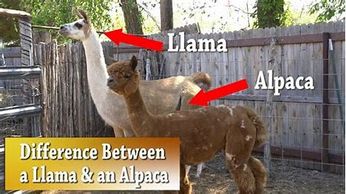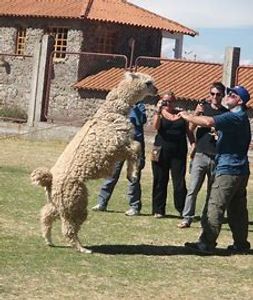Halter Fit
Good Halter Fit
Terrible Halter Fit
Terrible Halter Fit

This halter is fitted correctly. The nose piece is up close to the eyes and it is not so tight around that the llama can't chew. The crown piece behind the ears is up close to them which keeps the halter from sliding down over the soft part of the nose.
Terrible Halter Fit
Terrible Halter Fit
Terrible Halter Fit

This halter is so loose that the llama could easily escape. If you don't have a llama halter you can make a temporary one for leading using your catch rope. See the photo on the "How to do it" page.
Poor Fitting Halter
Poor Fitting Halter
Poor Fitting Halter

At first it looks like this halter is on correctly. But, the head strap is loose & has slipped down the back of the neck. The halter could move forward on the face. This would let the nose band cut off the air supply by sliding over the cartilage on the lower part of the nose.
Parts of the Halter
Poor Fitting Halter
Poor Fitting Halter

The nose of a llama has less bone than that of a horse or cow. That is why the halter fit needs to be up under the eyes where the skull is hard. If it gets down on the cartridge of the nose it can smother them. There should be space to slide 2 fingers between the chin and halter.
A picture is worth a thousand words
Portable panels
The difference between llamas & alpacas
The difference between llamas & alpacas
Portable panels such as these are usually available at your local feed store. They are tall enough that only the most agile llama could jump out. They are easy to move and set up, making them ideal for creating a feed area where loose llamas can be encouraged to enter.
The difference between llamas & alpacas
The difference between llamas & alpacas
The difference between llamas & alpacas

Llamas are larger than alpacas and have a high set tail. They are normally not as frantic when separated from their herd mates. Alpacas have spear shaped ears, a sloping rump with a low set tail and have more wool coverage down their legs than the majority of llamas.
Keep them cool.
The difference between llamas & alpacas
Leading without a halter

Llamas & alpacas love to be hosed down when it is hot. If you are concerned about heat stress, hose with cold water on the legs, belly & under the tail. Don't get the fiber on the back & neck wet as it will become a sauna & defeat your purpose.
Leading without a halter
Leading without a halter
Leading without a halter

In South America, none of the llamas wear halters. They simply lead with pressure from a rope around their neck. The higher up the neck that the rope is placed, the better control you will have. Most tame llamas will respond to this.
Spitting
Leading without a halter
Pecking order

Llamas will usually warn you that they are about to spit. When the head goes up, the ears lay back & you hear a gurgling or other vocalization they are saying "Back off or I will spit".
Pecking order
Leading without a halter
Pecking order

This llama is letting his pen mates know that they are getting too close. They will often use the spit threat to make others give them more space or establish a pecking order.
Aggressive animals
Aggressive animals
Aggressive animals

Llamas and alpacas are normally very gentle and safe to work with. It is extremely rare to find what we call a "berserk" llama or alpaca. Should you happen onto one, you need to understand that they are very dangerous. They will try to hurt you. You will need to contact a veterinarian or knowledgeable person who can give you advice about what to do.
This is a very rare trait but one you need to know about. It is caused by letting the babies imprint on people when they are young. They usually snap when they reach puberty at around two years of age.
Berserk llama syndrome
Aggressive animals
Aggressive animals

You will know a berserk animal because the will try to knock you down, spit and scream and act wild. Something snaps inside & they become insane. There will be no question in your mind if the animal is berserk.
A few friendly llamas or alpacas will run up to you and get in your space but that is entirely different form an animal that is trying to kill you. Berserk ones are best euthanized as it is not a trait that can be changed.
Llamas have a large personal space and will naturally stay 6 to 8 feet away from people & others of their kind.
Herding using outstretched arms
Winter care
Winter care

Llamas can be herded just by positioning people in the areas where you don't want the llamas to go. You can actually make a "people fence" by holding hands & quietly moving toward the llama. The key is to move slowly & not get too close or the llama will try to break through the "fence".
Winter care
Winter care
Winter care

Llamas can deal with the cold much easier than with the heat. They need shelter from the wind and plenty of feed and fresh water. Babies need to be kept in a warmer place and in extreme cold they should be covered with a coat. (A large size dog coat works well.)
Pad of a llama's foot
Pad of a llama's foot
Pad of a llama's foot

The foot is made of a soft leather pad with hard toe nails much like those on a dog. These shown are a bit long, but not so long that they start to turn in.
Nail clippers
Pad of a llama's foot
Pad of a llama's foot

Most feed stores sell this type of toenail clipper. You can also use rose pruning shears or horse nippers. Stand the animal in water for a while before trimming. The nails will be much softer and easier to work with.
How to trim toenails
Pad of a llama's foot
Long toenails

This diagram shows a favored method of trimming with the cuts numbered. Be careful not to cut into the quick which extends into the nail. Cut small amounts off first.
Long toenails
Long toenails
Long toenails

These toe nails curl in because the they need trimming. They can't be cut back all at once because the quick Blood supply) is down in the nail. Trim a little off every couple of weeks so that the quick has time to recede.
Sitting down
Long toenails
Fighting teeth

These animals sit down a lot. They often eat sitting down. Most will sit while traveling in a trailer or van. It is normal for them to have one or both legs stretched out in front of them.
Fighting teeth
Long toenails
Fighting teeth

Males grow sharp fighting teeth that must be cut off when they reach puberty. Otherwise they can do damage to other llamas or people. This photo shows the top fighting teeth, they also have them on the lower jaw. If the males have not had good care they will probably need their teeth cut. Do not try to pull them as the root is very long. Pulling will break their jaw.
Shearing
Most llamas are great with children
How to see if they are too thin

If the animal is suffering from heat stress or it is very hot or humid, shear at least the barrel or mid section. The llama in this photo has had the minimal amount shorn. This can be done using electric clippers or hand shears.
How to see if they are too thin
Most llamas are great with children
How to see if they are too thin

It is hard to tell if a llama is fat or thin because of the covering of wool. Use the above chart & put your hand in the middle of the back to gauge weight. Too far forward or back will give a false reading. The middle drawing is the desired amount of coverage.
Most llamas are great with children
Most llamas are great with children
Most llamas are great with children

Llamas are safe with children. They were domesticated centuries before the horse and have a long history of living with the Indians of the Andes Mountains. They make great pets and companion animals.
Site sponsors:


Copyright © 2018 International Llama Foundation - All Rights Reserved.
Powered by GoDaddy Website Builder